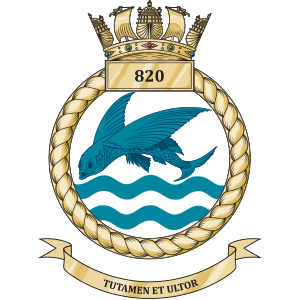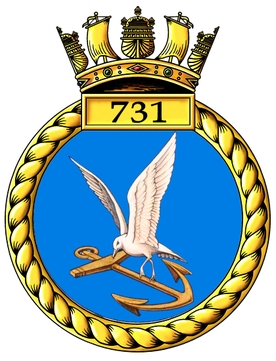
The Fairey Swordfish was a biplane torpedo bomber, designed by the Fairey Aviation Company. Originating in the early 1930s, the Swordfish, nicknamed "Stringbag", was principally operated by the Fleet Air Arm of the Royal Navy. It was also used by the Royal Air Force (RAF), as well as several overseas operators, including the Royal Canadian Air Force (RCAF) and the Royal Netherlands Navy. It was initially operated primarily as a fleet attack aircraft. During its later years, the Swordfish was increasingly used for anti-submarine and training duties. The type was in frontline service throughout the Second World War.

The Fairey Albacore is a single-engine biplane torpedo bomber designed and produced by the British aircraft manufacturer Fairey Aviation. It was primarily operated by the Royal Navy Fleet Air Arm (FAA) during the Second World War.

Royal Naval Air Station Lee-on-Solent,, is a former Royal Naval Air Station located near Lee-on-the-Solent in Hampshire, approximately 4 miles (6.44 km) west of Portsmouth, on the coast of the Solent.

811 Naval Air Squadron was a unit of the British Royal Navy's Fleet Air Arm. It was first founded in 1933, and served during World War II, seeing action in the battle of the Atlantic and on Russian convoys, and was eventually disbanded in 1956.

816 Naval Air Squadron was a Fleet Air Arm (FAA) naval air squadron of the United Kingdom’s Royal Navy (RN) which formed at the start of the Second World War.

701 Naval Air Squadron was a Fleet Air Arm (FAA) naval air squadron of the United Kingdom’s Royal Navy (RN), which last disbanded during September 1958 at RNAS Lee-on-Solent where it was a Helicopter Trials, Communications and Fleet Requirements Unit. It initially formed during July 1936 as a Catapult Flight operating out of Malta and routinely embarking in RN ships such as, HMS Barham, HMS Malaya, HMS Valiant and HMS Warspite. By autumn 1939 it was known as 701 Naval Air Squadron but disbanded in January 1940. It was active twice more during the Second World War, between May 1940 and June 1941 on special duties and then between October 1942 and August 1943 performing anti-submarine patrols. Reforming in April 1945 it was designated a Communications Unit, operating out of Heston until disbanding in 1947. It last reformed as a Fleet Requirements Unit at HMS Daedalus, Lee-on-Solent, during October 1957.

820 Naval Air Squadron is a Royal Navy Fleet Air Arm carrier-based squadron flying the AgustaWestland Merlin HM2 in Anti-Submarine and Airborne Early Warning (AEW) roles from RNAS Culdrose.
821 Naval Air Squadron was a Royal Navy Fleet Air Arm carrier based squadron formed on 3 April 1933 with the transferral and amalgamation of the Fairey III aircraft from 446 and half of 455 Flight Flights Royal Air Force to the newly formed Fleet Air Arm of the Royal Air Force. The squadron operated during the Second World War.
810 Naval Air Squadron was a Royal Navy Fleet Air Arm carrier based squadron formed on 3 April 1933 with the amalgamation of the 12 Blackburn Dart aircraft from 463 and 44 Flight Flights Royal Air Force to the Fleet Air Arm. The squadron saw action during the Second World War, the Suez Crisis and the Korean War.

828 Naval Air Squadron was a Royal Navy Fleet Air Arm carrier based squadron formed in September 1940 as a torpedo spotter reconnaissance squadron. It operated in a number of the theatres of the Second World War, carrying out a number of attacks on enemy targets including the Tirpitz in Norway.

813 Naval Air Squadron, was a Fleet Air Arm (FAA) naval air squadron of the United Kingdom’s Royal Navy (RN) during World War II and again post-war. It initially operated Swordfish Mk Is from the aircraft carrier Illustrious and took part in the successful raid on Taranto in November 1940.
823 Naval Air Squadron was a Fleet Air Arm aircraft squadron before and during World War II.

713 Naval Air Squadron was a Fleet Air Arm (FAA) naval air squadron of the United Kingdom’s Royal Navy (RN) which was disbanded in late 1945. It was first formed from 445 Flight in 1936 and operated with Fairey Seafox floatplanes from RAF Kalafrana at the onset of the Second World War and subsequently integrated into 700 Naval Air Squadron in January 1940. The squadron was re-established at HMS Urley, RNAS Ronaldsway, Isle of Man, in December 1944, functioning as a Torpedo Bomber Reconnaissance Training Squadron, where it operated with Fairey Barracuda aircraft.

731 Naval Air Squadron was a Fleet Air Arm (FAA) naval air squadron of the United Kingdom’s Royal Navy (RN). It was active between 1943 and 1945 and its sole role throughout its formation was a Deck Landing Control Officer training squadron. Through this role the squadron pilots were nicknamed 'Clockwork Mice'. It was based out of the purpose built airbase, commissioned as HMS Peewit, known as Royal Naval Air Station East Haven, in Scotland, as part of the Deck Landing Training School there.

753 Naval Air Squadron was a Fleet Air Arm (FAA) naval air squadron of the United Kingdom’s Royal Navy (RN). It was active as an Observer Training Squadron from 1939 to 1946 as part of No. 2 Observer School, forming out of the School of Naval Co-operation RAF, in May 1939. Initially at RNAS Lee-on-Solent, the squadron moved to RNAS Arbroath just over one year later in August 1940, following a German bombing attack on the air station. It spent four years operating out of Arbroath, before relocating again, this time to RNAS Rattray, where the squadron disbanded in August 1946.

763 Naval Air Squadron was a Fleet Air Arm (FAA) naval air squadron of the United Kingdom’s Royal Navy (RN). It formed in 1939 as the Torpedo Spotter Reconnaissance Pool No. 1, at HMS Kestrel, RNAS Worthy Down. Three months later, it moved to the short-lived RNAS Jersey, in the Channel Islands, before moving back to Worthy Down via HMS Daedalus, RNAS Lee-on Solent and disbanded in 1940. The squadron reformed, on the seaplane carrier HMS Pegasus, as a Seaplane Training Squadron, in 1942. This role lasted around two years and the squadron continually operated and provided training from HMS Pegasus, until disbanding in 1944. Roughly two months later, the squadron reformed again, this time at HMS Nightjar, RNAS Inskip, as an Anti-submarine Operational Training Squadron and remained in this role for just over one year, disbanding in July 1945.

769 Naval Air Squadron was a Fleet Air Arm (FAA) naval air squadron of the United Kingdom’s Royal Navy (RN). It last disbanded and merged with 717 Naval Air Squadron after the Second World War. 769 Naval Air Squadron Formed at HMS Merlin, RNAS Donibristle, during May 1939, by renumbering 801 Naval Air Squadron. Its role was a fighter Deck Landing Training Squadron, using HMS Furious for advanced training, before disbanding in the December. It reformed in November 1941, as a unit within the Deck Landing Training School at HMS Condor, RNAS Arbroath, and in November 1943, it moved to HMS Peewit, RNAS East Haven. Its role changed to Torpedo Bomber Reconnaissance Training in 1944, before moving to HMS Merganser, RNAS Rattray, in July 1945.

785 Naval Air Squadron was a Fleet Air Arm (FAA) naval air squadron of the United Kingdom’s Royal Navy (RN) which disbanded in early 1946. 785 NAS formed as a Torpedo Bomber Reconnaissance Training Squadron, at HMS Jackdaw, RNAS Crail, in November 1940. Throughout its existence it operated a number of various types of torpedo bomber aircraft. The squadron became part of No. 1 Naval Operational Training Unit in late 1944.

788 Naval Air Squadron was a Fleet Air Arm (FAA) naval air squadron of the United Kingdom’s Royal Navy (RN) which last disbanded during June 1945. The squadron formed at RN Air Section China Bay in Ceylon, in January 1942, as the British Eastern Fleet's Torpedo Bomber Reconnaissance Pool, however it lost half its strength during the heavy raids by Japanese carrier-borne aircraft in the April. The squadron regrouped at RNAS Tanga in Tanganyika, East Africa to become a Fleet Requirements Unit and relocating almost immediately to RN Air Section Port Reitz, in Mombasa, where it remained operational for the next three years.

















